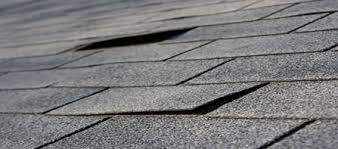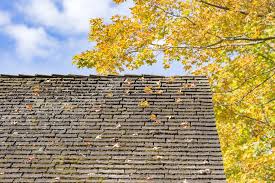How can you tell when you need a new roof?
As a homeowner, you’re all too familiar with the different parts of your house that you need to maintain. If you neglect any one aspect of your home, it could mean detrimental damage to many other features of your house. It could also impact the curb appeal, which would lower the value of your home. Such is the case with waiting too long to get a new roof. If you feel like your roof might be nearing the end of its life, you need to consider replacing it soon.
Here’s how to tell if you need a new roof. Use these signs to consider whether your roof needs replacing.
Visible Streams of Light Through the Boards
Have you noticed a weird looking sun glare on your floor or wall that wasn’t there before? If you haven’t been able to identify where it’s coming from, you might want to make sure it isn’t coming from up above you. Take a look at the boards of your ceiling in your attic and see if you notice any streams of light shining through it. If so, that means your roof has been compromised. If the light is leaking through your roof, so is water when it rains. The only solution to this is reaching out to an asphalt roofs expert right away to install a new one.
Look at Your Documentation
Asphalt roofs can typically last you several decades barring an emergency, or around 20 to 25 years to be exact. It might be more or less depending on the year-round weather where you live. Now that you know that, it’s time to take a look at the documentation of your house to see how old your current roof is. If you were the first to ever occupy the house, it might be a bit easier to remember off the top of your head. Either way, if the timing is coming up quickly, you’ll want to reach out to a roofing specialist right away. That’s not to say you automatically need to replace it. Schedule an appointment for them to come out and do a checkup on its condition. They might tell you that you have a few more years in it before it needs replacing. Wouldn’t that be nice?
Stains or Cracks
Have you noticed markings on the inside of your ceiling? You might notice some dark stains, cracking, or morphing of your ceiling’s interior. If so, take it as a sign that there is either a leak or an immense amount of moisture that’s caused these markings to appear. The longer you hold off on getting that corrected, the more damage it will do to your home’s structure and the wider that it will spread.

Curved Shingles
If you’re not sure whether it’s time to reach out to a roofing service, take a climb up the ladder to inspect the roof for yourself. One of the most noticeable signs that you need to contact a professional is if you notice curved shingles. That shows that the material is starting to fade and that you need to replace it. If you neglect them, it will lead to water falling through and starting to find cracks to leak into.
Sagging Ceiling
If you have noticed that your roof is starting to sag, it’s a sign that your roof has a monumental leak on it. The leak has probably gotten so bad and has been adding to itself for so long that immense pressure is weighing down your roof. The humidity between the different layers will only worsen it. Not sure whether it’s moisture damage or something else? Take a broom to it. If it feels soft and mushy as you press on it, then it’s a sign of trapped moisture. You need to call an expert right away. Only they will know how to go about fixing your ceiling’s issues so that it doesn’t end with water all over your bedroom floor.
Green Marks on Your Roof
You need to take the time every so often to climb up on the top of your roof and inspect the quality of it. As previously mentioned, the condition of your roof’s shingles can be a telltale sign for a roof replacement. However, you’ll also want to make sure there isn’t any moss growing on top of it. If there is, it’s a sign there is moisture getting trapped somewhere within that vicinity. Brush away the moss with a brush that has a stiff profile but doesn’t brush hard enough to cause more damage to the roof itself. After you’ve brushed away the moss, take a closer look at the roof and inspect for any cracks or holes.
Your Tiles are Rotting
This is possibly the most obvious sign that it’s time for a new roof, even to the untrained eye. If you notice that your tiles have become rotten or are even missing tiles, it’s time to find an expert you can reach out to about a replacement. The rotting will only continue to grow worse, so be sure to get things in order right away so that you don’t have any (further) damage to your home.

Got Leaks?
The most obvious clue you might need a new roof is finding water inside your home. Regularly check your attic, especially after a rain storm or if you notice an ice dam along your eaves. Look for signs of water penetration because major leaks inside your home are most likely to start there. Keep in mind, though, that water can travel a fair distance – across beams and inside walls for example – from the point of infiltration to where it eventually shows itself.
Ice dams form when snow on the roof melts, runs down slope to the eaves and freezes. As more water runs down and encounters the ice dam, it may then run up and under the asphalt roofing shingles, potentially penetrating the roof deck.
As mentioned above, a total roof replacement may not be necessary to correct such a problem. Perhaps a few shingles have blown off or some flashing has torn loose, exposing the underlying roof deck to the elements.
Water Stains
On the ceiling or running down interior walls and water actually dripping into your home are all cause to investigate and discover the reason, which might be a leak or is often the result of condensation. It’s especially in the winter that warm, moist air rises and often condenses in the attic, where it can pool and leak through the ceiling. Most water leaks start smaller than the ones shown below. Check for the source of leaks at the first sign of water marks. While they’re not always caused by a roof problem, any leak is a concern that needs to be resolved as quickly as possible in order to minimize damage and expense.

Paint Damage
Paint peeling or blistering, swellings in woodwork or trim – indoors or out – can be caused by water pooling up underneath where it doesn’t belong. These types of blemish are much more than cosmetic; they indicate a serious leak that may or may not be caused by a faulty roof, although that is a prime suspect to investigate.
Mold
Mold or mildew growth on ceilings or walls could be a sign of a leaky roof, the result of condensation problems or even a simple plumbing issue. Check that your insulation is dry, your home has adequate ventilation, your bathroom fixtures and plumbing lines aren’t leaking or sweating. Such things may be less costly to correct than getting a roof replacement. Apart from creating ugly stains and indicating potential roof damage, mold and mildew can have an adverse effect on home air quality and your family’s health. Have the issue addressed as soon as possible.
Granule Loss
When clearing your eavestroughs of leaves in the fall, you may notice that some colored granules have accumulated in the gutters. Depending on the age of your roofing shingles and normal weathering processes, this is not unusual. An excessive amount of granules might be cause for concern. But what is considered “excessive”?
While there’s no way to definitively quantify how much granule loss is too much, the best indication is to look at the roofing shingles themselves. When asphalt shingles are manufactured, more granules are embedded in their surface than are actually necessary so it’s only natural that the superfluous, loose granules would wash away first. Even on brand-new shingles, you can make out the black asphalt the granules are embedded in. However, if the asphalt shingles on your roof have relatively large bare patches where the granules have eroded away and exposed the underlying black weathering asphalt to the elements, you will need to replace any damaged shingles. If the problem isn’t limited to just a few shingles, it may well be time for a roof replacement. A reputable contractor can help you decide.